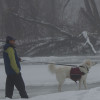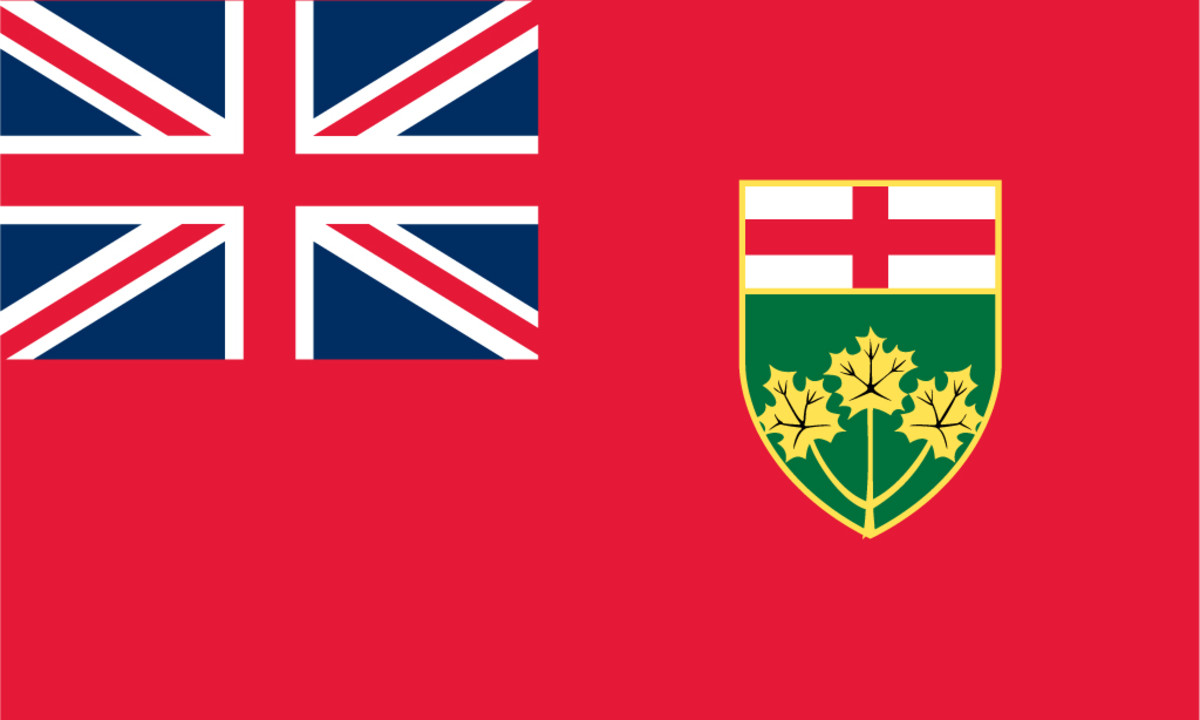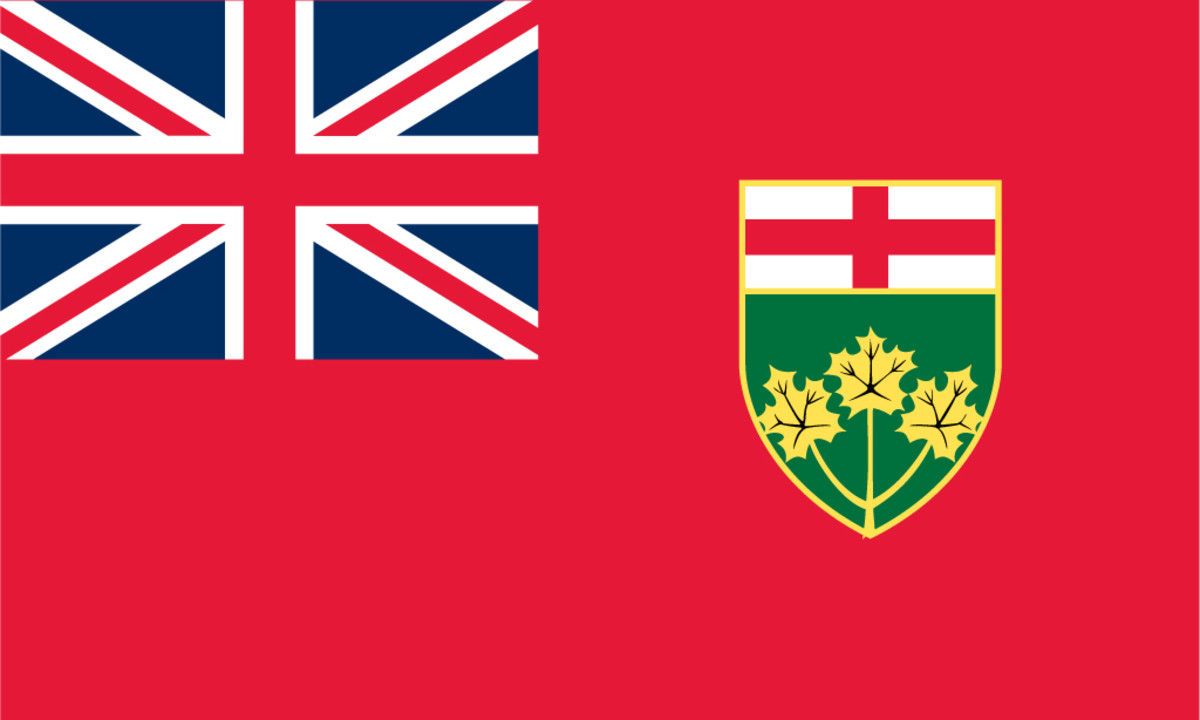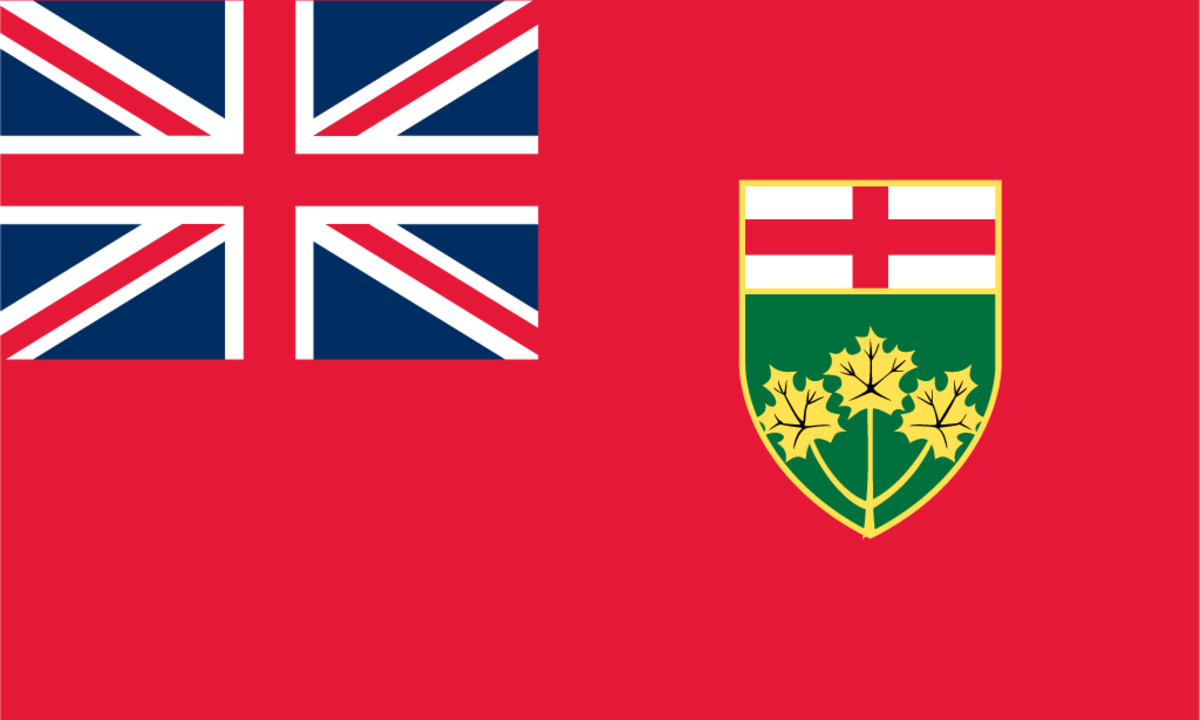Beautiful Ontario - Hiking in Bruce Peninsula National Park
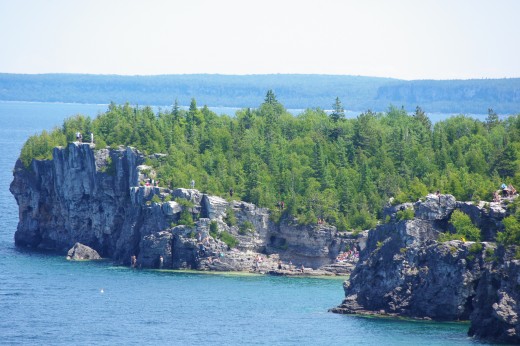
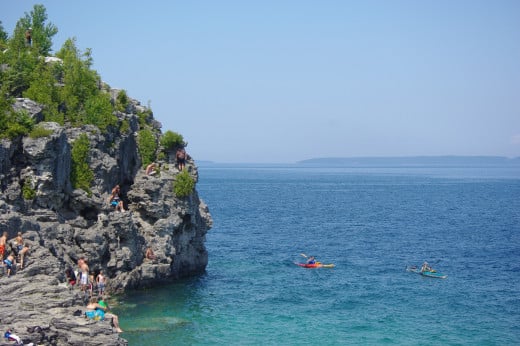
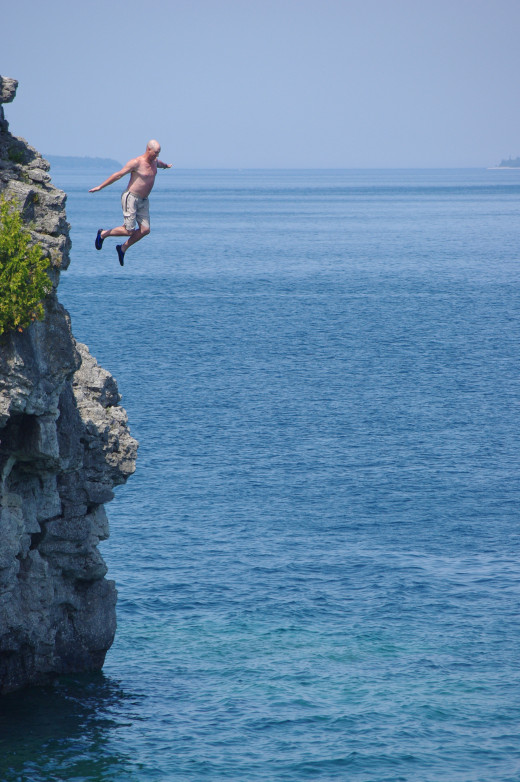
As the lonely trail led us to a rocky outcrop at the Indian Head Cove, we glanced casually down at the rocky Georgian Bay lakeside some 10 meters below and were pleasantly surprised to see hundreds of visitors, many with their dogs, picnicking by the crystal clear waters.
A group of daredevils had climbed a rock which was standing tall over the waters at about 20 meters high and was preparing for cliff jumping. We looked in horror as the lead jumper was about to unknowingly jump on two snorkelers in the water directly below him. He prepared himself for jumping and many visitors yelled in alarm, stopping a calamity in the making. Finally, when the snorkelers cleared the waters, the man jumped and splashed into the water, making some visitors clap in appreciation. Oblivious to this great feat, two sea kayakers pedaled pass by fully focused on their elegant strokes. Far out in the lake, couple of islands of the neighbouring Fathom Five National Marine Park were shimmering on the clear early morning sun.
We picked the Bruce Trail again and reached the rock where jumpers were stationed only to see a post warning visitors against cliff jumping as “it could result in serious injury and even death.”
The park, consisting of Georgian Bay coast; cliffs; cobbled and rocky beaches; many inside lakes; forests; unique flora and fauna; hiking trails; and camping sites, offers many water and land based activities.
What interested us in this park, a family of 4 (with two teen-aged children), was the fact that a section of 782 km-long famous Bruce Trail, Ontario’s mini version of the Appalachian Trail in the US, runs through the national park. We have been exploring its various sections off and on. Since it offered varying degree of difficulty all along the shoreline, we decided to hike on a track from ‘Overhanging Point’ in the west to ‘Crane Lake’ in the east. Inclusive of access trails through the dense forests, this meant only 25 km, but certainly felt like more than that due to several stretches where the trail went over rocks and cobble beaches.
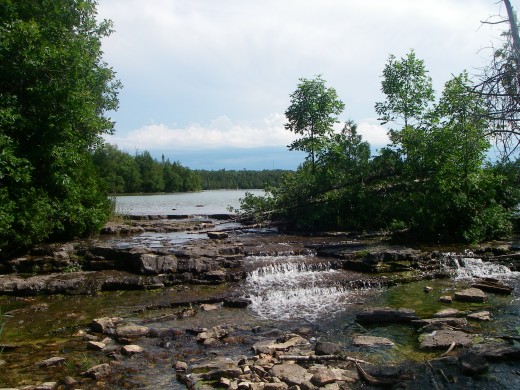
Hiking from Cyprus Lake to Indian Head Cove
From highway 6, we took Cyprus Lake exit and reached the Park Registration Office. We bought our entry pass, collected brochures, and got some necessary information before heading off to the end of the road. It was early in the morning, but anyone could tell that it was a sunny and hot day in the making. We took the Georgian Bay Trail to reach Indian Head Cove. The trail passed over a stream of gushing water coming out of Cyprus Lake and flowing towards the shore. Children were delighted at identifying oxeye daisies, orange hawkweeds, and birds-foot trefoils all along the trail.
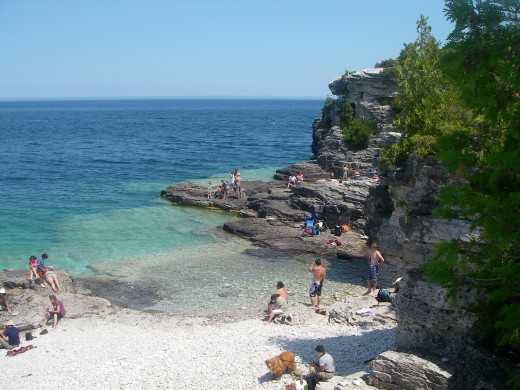
Trying to swim at Indian Head Cove
This was the first destination on the shore from the Park Office. It was only 8 in the morning, but the sunlight reflected off the water and wet rocks made us reach for our sunglasses. The elements had artistically carved the rocky shoreline, which was very popular with picnickers. The calcareous nature of lakeside cliffs had helped in formation of many caves that the children were exploring.
I dipped my one foot to determine water temperature. It was freezing. I opted out. Someone chipped in with an advice, “You gotta just jump in and everything will be fine.” Not being able to gather the courage, I declined to heed. However, that did not seem to discourage new arrivals. A group of 5 pre-teens jumped directly into the water upon arrival and swam back to the shore quickly, physically shivering, but mentally shell-shocked. Their embarrassment and their parents’ laughter bailed me out.
We made a ‘base camp’ here for our day-long stay in the park. Since the purpose was to hike, that is what we exactly embarked upon from here.
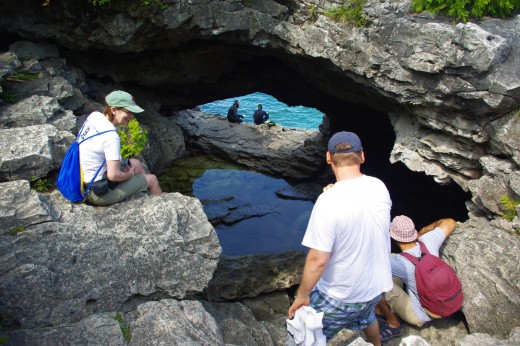
At the Grotto
It was 10 a.m. and the bright sun felt like burning our skins. We hiked westwards for quarter of a kilometre over large rocks and through hundreds of beach and caves lovers to reach the high cliffs at the Grotto (picture). A grotto (Italian grotta) is any type of natural or artificial cave that is associated with modern, historic or prehistoric use by humans. Naturally occurring grotto is a small cave near water and often flooded or liable to flood at high tide.
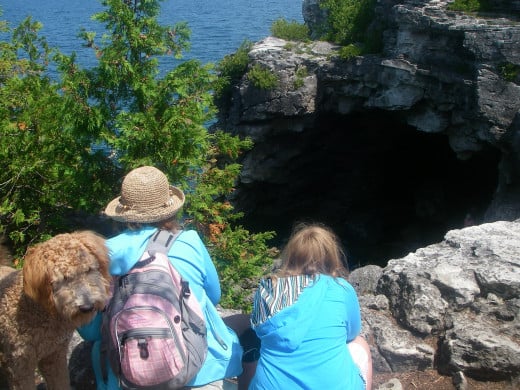
This was perhaps the most popular spot in the national park, albeit to slight discomfort of our naturalist minds. Cave lovers, snorkelers and children were squeezing pass a crevasse to reach the Grotto at the bottom of the cliff. From the top of the cliff, one could have a panoramic view of the entire shoreline, the mud coloured rocky beach, green forest covered cliffs, colourfully crowded rocky beach of Indian Head Cove, turquoise blue waters of the Georgian Bay, and silhouettes of couple of islands of the neighbouring Fathom Five National Marine Park out in the far background.
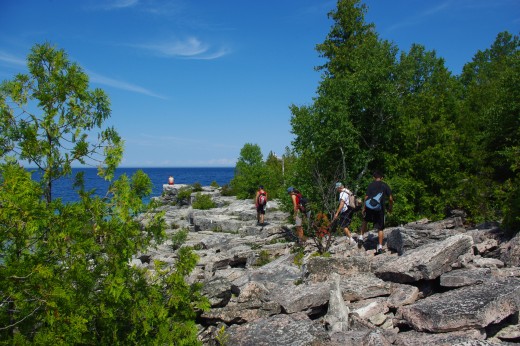
Hiking towards the Overhanging Point
Hiking on the Bruce Trail westwards to the Overhanging Point from there on turned out to be difficult as a small section of the hike was over rocky terrain and then a cobble beach that required careful balancing. A slight misjudgement could force the hikers into doing a downward bound ‘whirling Dervaish’.
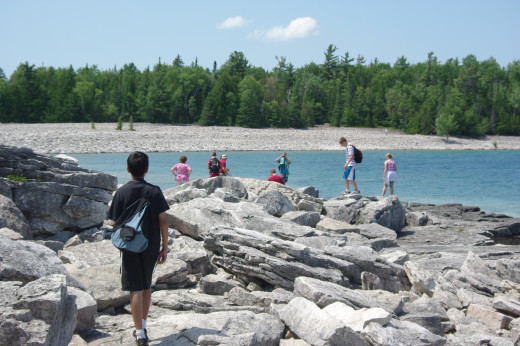
A bikini clad over-enthusiastic girl in her early 20s, apparently headed for the beach, lost her balance, and before anybody could respond to her cry for help, was penalized by the unforgiving nature with bloody bruises and a blushed face. Many other hikers gave up in the middle of the cobble beach. Where humans wilted, some resilient wildflowers had chosen tiniest of spots between rocks to bloom and show off their radiant colours. Sunglasses failed against the sunlight. Out came the baseball caps from our backpacks for supplemental defense.
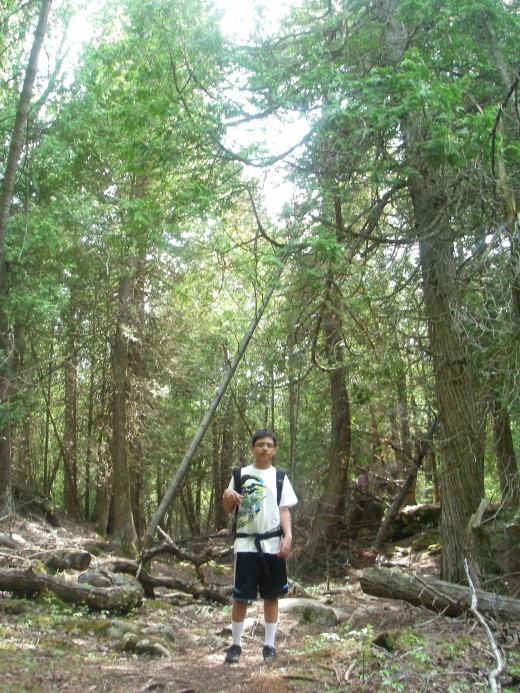
Once we crossed this section, the trail ascended sharply into the dense forest and became easier to traverse.
Out in the open, burning sun was at least accompanied by a light breeze. In the forest, it was hot and humid. We started sweating profusely. This reminded us of our frequent hikes on the Appalachian Trail in Virginia and North Carolina.
The temperatures here were 10 C less, but felt equally challenging. The smell of wildflowers and freshly trampled and rotting foliage, damp soil and our sweat drenched T-shirts fused together into something that was refreshing and disgusting at the same time.
We found trees with their roots on soil surface like serpents, trying to get a hold of anything they could find. Some of them were uprooted by a recent storm to expose thinness of soil over the rock bed. This explained why the hearts of earlier settlers were broken when they tried to plough the land. Due to this unique geological feature, their pioneering days were doomed from the start.
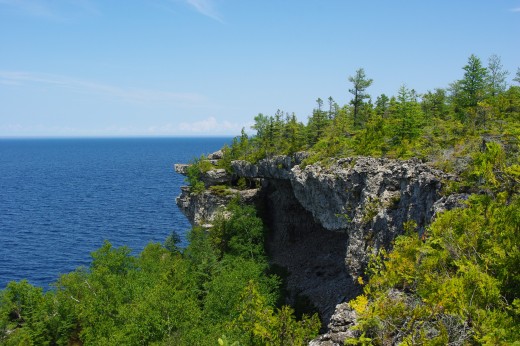
At Overhanging Point
The Overhanging Point is named so because this portion of the cliff is not supported by ground below it, which is one of the main features of the Niagara Escarpment (see picture). This outcrop is the most photographed spot of the national park with many a picture of hikers / couples taken for showing off and for making posters.
This section of the trail was quite popular with hikers, many of them with their dogs on the leash, starting from Tobermory and heading for the Grotto. Wood lilies and an assortment of wildflowers bloomed along the trail. We then doubled back to our base at the Indian Head Cove.
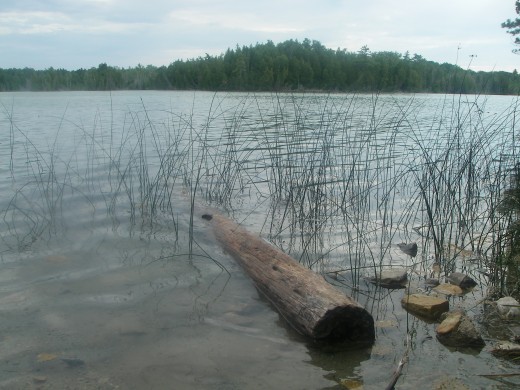
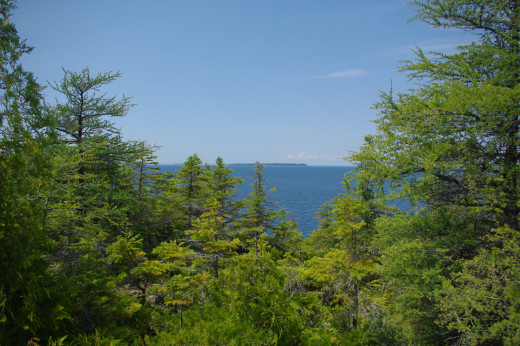
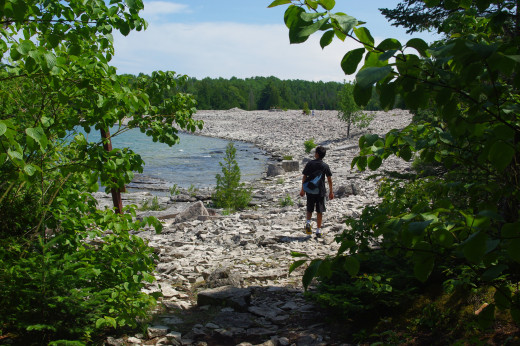
From Halfway Rock to Cave Point to High Dump to Crane Lake Parking Lot
My son and I hiked on this 8.5 kms of the trail as the other two members opted out in favour of Cyprus Lake. The trail offered fantastic lookouts of the rocky shore and crystal clear waters. The two of us met only 3 hikers on this long tract of Bruce Trail. Drinking lots of water and stopping at scenic outlooks or to observe wildflowers were our preoccupations.
At High Dump, the Bruce Trail said goodbye to the Georgian Lakeshore and turned south i.e. inwards into the deep forest. The sound of the waves breaking on the rocky shores gave way to total silence where the two of us could hear the swishing of our clothes and thudding of the hiking boots in a vast expanse of timelessness. Occasionally, a blue jay took to wings protesting at our intrusion in its territory in a characteristic annoyingly loud, almost gull-like scream.
The only other incident was when I heard an unusual rustle in the bush. I looked at my son and deciding to test his concern, inquired, “deer?..... bear?”
My son recalled his knowledge gained at the Park office brochure and replied, “Dad, there are 80 bears spread all over the park. Even if it is a bear, it is probably smaller in size as all animals are smaller here compared to their cousins elsewhere, and as much scared of us as we are of it.” I found the response satisfying.
This was an 8 km long hike that meandered through forest and through a number of lakes, namely, Warder Lake, Quenlin Lake, Upper Andrew Lake, and Moore Lake to reach the Crane Lake Parking Lot, where we were picked by my wife and drove back on Crane Lake Road back to Highway 6, finally joining with my daughter at our base camp on Indian Head Cove.
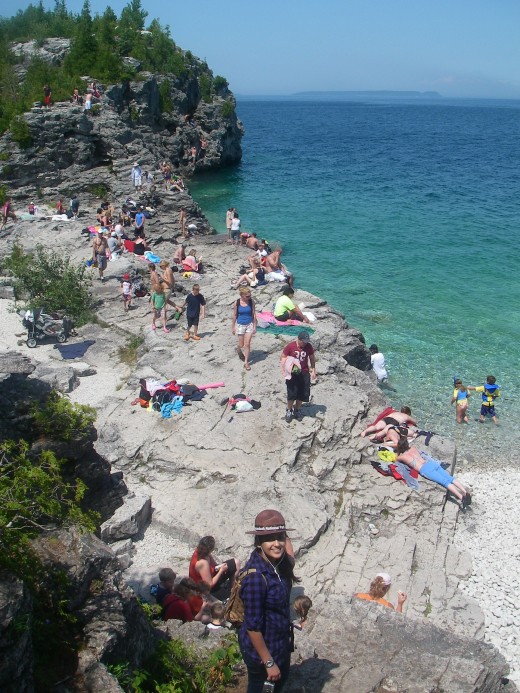
Back at the Indian Head Cove
We had an early dinner back at the Indian Head Cove, where many other families were still coming in to enjoy the beach in late summer sun. Although we had brought delicious sandwiches, the aroma of barbeques was so strong that we could almost taste the steaks, kabobs and fish.
As the children went down the crevasse to explore the Grotto, my wife and I reflected on the day-long adventure. We had not even covered quarter of the Bruce Trail that passed through the national park. An entourage of various age groups appeared on the rock. A man in his 60s holding on to the leashes of two St. Bernards was alerted for his picture to be taken.
Turning towards us, he asked, “Do I look OK?”
My wife responded, “Well you are standing on top of the world, holding on to the leash of two majestic St. Bernards with the Grotto appearing in the background. What else do you want?”
The entourage chuckled and dispersed away. Children came back and showed bruises on their hands, their palms as coarse as the rocks they negotiated to get to and out of the Grotto.
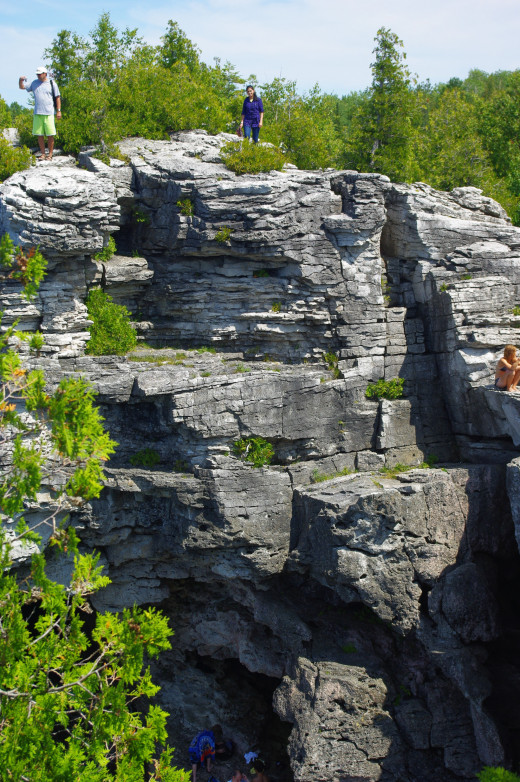
Cliff jumpers continued their frenzy. A girl in her mid-teens seemed preparing to jump this time.
“Don’t jump, there are children swimming at the base of the rock”, someone yelled.
“I am not jumping”, the girl shouted back, clarifying her take on the proceedings.
“Stop pulling the Lion King on us then”, protested another visitor recalling the rocky outcrop from the famous movie.
Although she did not jump, there were others defying logic and sense.
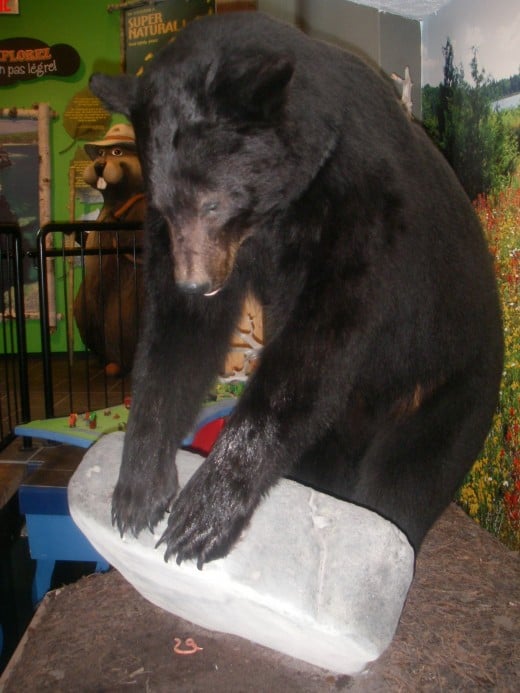
Important information:
Other features of the Park include its endemic wildlife adapt to subsistence living due to thin soil over the rock bed. Commonly seen wildlife on The Bruce Peninsula National park includes chipmunk, squirrel, raccoon, porcupine, snowshoe hare, skunk, white-tailed deer, snakes and frogs. Black bear, fox, fisher, martin and the Massasauga rattlesnake call it home too, but are less ubiquitous.
Two other distinct features of the park are alvars and one of the oldest eastern white Cedars hanging on to the cliffs. Alvars are naturally open habitats with either a thin covering of soil or no soil over a base of limestone or dolostone. This feature is found only in the eastern European Baltic region and the North American Great Lakes Basin. Almost 75 percent of North American alvars are located in Ontario.
How to get there
The Park can be reached by taking north exit of Hurontario Street (Highway 10) from Highway 401. Continue until Highway 10 north joins Highway 6 north (coming from Guelph) at Owen Sound. Follow Highway 6 north past Owen Sound and Wiarton (a town at the base of Bruce Peninsula) all the way to the picturesque Tobermory, which is the last town on Bruce Peninsula with a population of 4,200.
Where to stay
For those interested in an affordable and comfortable extended stay, Tobermory and Highway 6 all along the park offer reasonable accommodations. However, advanced booking is highly recommended due to the popularity of the peninsula with the tourists.
Popular
Visiting the Campbell Block, The Junction, Toronto, Ontario: Ornate Building Formerly Housing a Hotel, Dating From 1888
Visiting the Former Victoria Presbyterian Church, The Junction, Toronto, Ontario: Romanesque Revival Style From 1891
Visiting 'Community', Sculpture by Kirk Newman, at 200 Bloor Street East, Toronto, Ontario: Stillness Amidst Movement
